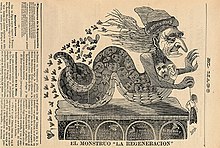
The Regeneration (Spanish: La Regeneración) was a political movement that emerged in Colombia in the late second half of the 19th century, led by Rafael Núñez. Its goal was to reverse the social and legal implications of the Radical Olympus era (Olimpo Radical) of the 1863 Constitution of Rionegro which established the United States of Colombia, made the country a federal republic and enforced the separation of church and state.[1] The motto of Regeneration was "one nation, one goal, one God" (una nación, un lema, un Dios).
The movement was mainly constituted by members of the Conservative Party and the moderate faction of the Liberal Party and opposed the then in office, Radical Liberals. After the civil war of 1876, President Aquileo Parra was the last leader of the so-called "Olimpo Radical era" (Radical Olympus). Parra was followed by General Julián Trujillo, who in 1878 had won the support of the moderate faction of the liberal party. At the moment, Núñez was the leader of the majority of congress in his address in the inauguration of Trujillo on April 1, 1878, he stated: «We have arrived at the point in which we are confronting this very dilemma: a fundamental administrative Regeneration or catastrophe».[2]
- ^ Cite error: The named reference
:0was invoked but never defined (see the help page). - ^ Gómez Martínez, Eugenio (February 2013). "Curiosidades y Más que Curiosidades de la Regeneración". Revista Credencial. Retrieved February 12, 2020.